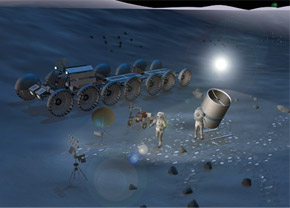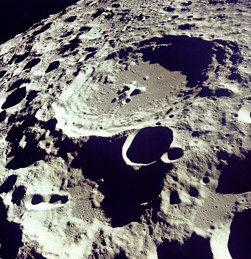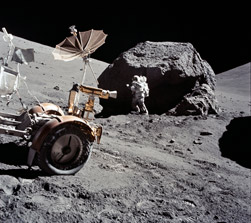
Q. Could you talk about the lunar missions in preparation around the world?

Lunar Observatory (Courtesy of NASA)
To begin with, there is a current trend towards using the Moon as a technological development site. The U.S. wants the Moon to be a relay base for human Mars exploration. It takes two years to travel to Mars, which means four years for a return trip, while it's only three to four days to the Moon. So we'll be able to learn how to live for a long time in space by staying on the Moon for several months and returning to Earth. The Moon will be a great place for this kind of preparation. Also, many countries are interested in surveying lunar resources, because it'll be very efficient if we can get fuel for spacecraft on the Moon. I hope that Japan will get involved in such technological research, too.
In addition, there is a desire to observe the universe from the Moon. A lunar day is equivalent to 14 Earth days, and a lunar night also lasts 14 days. Earth-based astronomical observation has to be done at night, within a brief 12-hour window, so a “night” that lasts 14 consecutive days will allow quite a different type of observation. We might even be able to see the edge of the universe from the Moon.
Also the far side of the Moon gets no interference from light or radio waves from Earth, so it's well suited for observing objects in space. Using a radio telescope on the lunar far side, it might be possible to see the universe with radio waves in a new range of wavelengths. Just as infrared observation and X-ray observation have contributed to new discoveries of the universe, I'm sure that more discoveries will be made at an astronomical observatory on the Moon. Such an observatory is also under consideration in Japan.
Apart from the U.S. lunar missions, last year Europe's lunar explorer SMART-1 traveled to the Moon with a primary mission of developing solar-electric propulsion technology to be implemented in further missions, such as a mission to Mercury. At the moment, the Europeans don't have a specific plan for their own lunar explorer, but I think they will be collaborating with other countries soon. China is launching a lunar-probe satellite this spring, and India's is scheduled for launch at the beginning of 2008. These are remote-sensing satellites like SELENE, designed to explore the Moon from above. Russia is also planning a mission similar to Japan's LUNAR-A, to investigate the lunar subsurface structure using penetrators.
Q. What have we already learned about the Moon through lunar exploration?
I think one of the greatest discoveries of the Apollo missions is that the temperature during the birth of the Moon was high, and that there used to be magma oceans. Before the Apollo missions, it was commonly believed that the Moon was formed very quietly and had remained cool. However, all the rocks brought back by Apollo astronauts turned out to be more than 3 billion years old. This means that there were molten regions on the Moon during that time period. This discovery led to the universal acceptance of the theory of a hot origin of the Moon, which indicates also hot origins of other terrestrial planets. If a small planetary body like the Moon was hot during formation, larger planets, including Earth and Mars, must have been even hotter at that stage. It was previously believed that planets were cool at birth, and that they were formed with cold chunks of interplanetary debris. So from this point of view, you could say that the Apollo missions have changed the fundamental view of the origin of planets.
Although the concept of magma oceans and the hot origin of planets have been widely accepted in the study of planetary formation in the solar system, the details of the planetary formation process have yet to be worked out. For example, the depth of the lunar magma ocean is still a mystery, so I'm hoping that SELENE will find the answer for us.

Moon craters (Courtesy of NASA)
The second biggest discovery of the Apollo missions is that the density of lunar craters is higher on older surfaces and lower on younger surfaces. Craters are caused by collisions with meteoroids, and the crater density is obtained just by counting craters larger than a certain size in a given area. The younger surface areas of the Moon, called "maria," appear dark. In such regions, craters produced during the pre-mare period have been covered with dark basaltic lava released from the Moon's interior and erased from the lunar surface. The rocks from there, known as "mare basalts," are relatively younger, with a formation age between 3 and 4 billion years. On the other hand, regions that look whitish are called highlands, and have much greater crater density. By analyzing highland rocks, scientists have estimated that the highlands are more than 4 billion years old. Crater density on the other planets, such as Mars for example, is likely determined by similar dynamics. So, the age of a region can be estimated by the crater density on the planetary surface. This method, which was established by lunar exploration, is called crater chronology.
A third discovery is in the area of planetary topography. There are huge plains, the lunar maria, created by flood basalts, which run 1,000 to 2,000 km on the lunar surface. This type of plain is commonly seen not on Earth, but on other rocky planets. The Moon also has a giant crater with a diameter of about 2,000 km, which is almost half the Moon's diameter. This large scar was caused by an impact that could have almost destroyed a planet, and similar-sized giant craters have also been observed on other planets. There was probably such a crater on Earth, too, at one time, but it must have disappeared sometime in the geological past. The Moon has unique topography such as great lava plains, a giant crater, and hills in the center of craters (called central peaks). Although these are typical of planetary topography, their formation is not yet well understood. These mysteries will be solved by investigating the Moon, which will also help us learn about other planets. I think that the Moon is like a textbook of planetary science. Reading it will help us understand other planets.
And the last discovery is the lunar magnetic anomaly I mentioned earlier. I think SELENE will enhance our knowledge of lunar magnetic fields, which will be very interesting. There are more discoveries not mentioned here, but I think these are the four major ones.
Q. What do you think are the pros and cons of human lunar exploration?

The first geologist flew to the Moon on Apollo 17 (Courtesy of NASA)
The negative aspect of human exploration is the cost. It necessitates large-scale missions because of the need to guarantee human safety. However, I still support human exploration. Many people might think that robots can handle what humans do, but I don't think that's always the case. Robots lack the most important element - the human capacity for inspiration and imagination. For example, geologists collect samples by walking through mountain ranges themselves. They wouldn't be able to conduct significant research if someone else went to gather samples for them. Ideas of how strata or a region were formed are often inspired by direct observation of where and how rocks lie - it's something that scientists must see with their own eyes. No matter how much data robots can collect, I don't think they will ever have the capacity for inspiration. On the other hand, humans, whose brains have absorbed and assimilated data, can be inspired by the mere hint of an idea. But this doesn't happen unless they go to a site in person, and this is why I think that scientists should go to the Moon.
Q. What do you think Japan's role should be in international lunar exploration?
I think Japan's role should be to release acquired data as quickly as possible and to collaborate with scientists around the world. Although lunar or planetary exploration is a national enterprise, I believe that the collected data is an international resource, and that it's important to share the information with people in other countries. As far as sharing responsibilities is concerned, Japan is a leader in research on rocks and the lunar interior, so I think Japan should take charge in these areas.